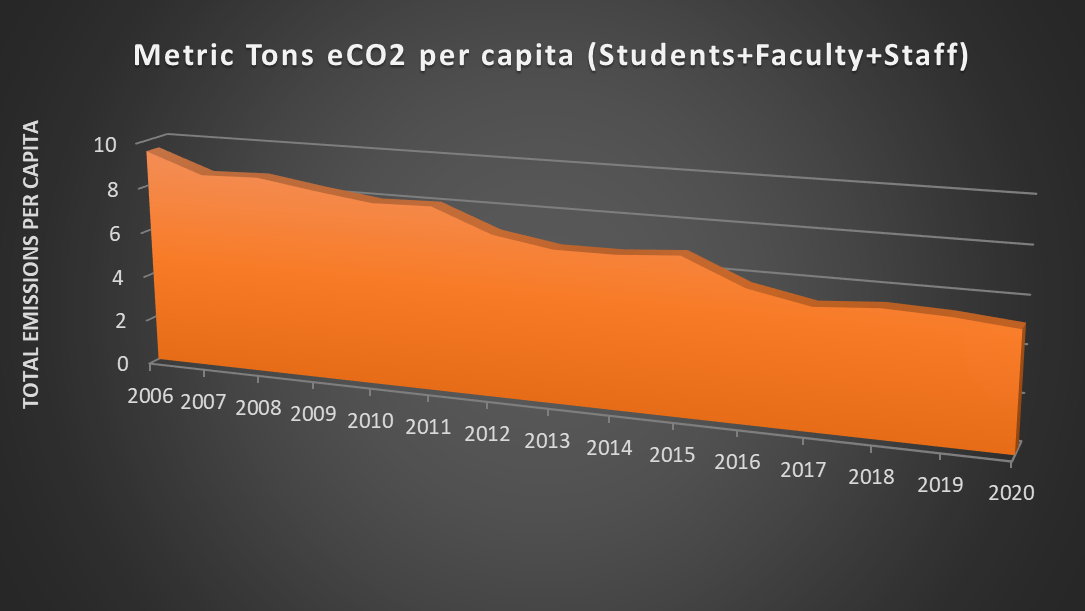UofL Greenhouse Gas Emissions Down 25% since 2006
 Our efforts to implement our Climate Action Plan have been paying off for many years, but a troubling reversal of progress has occurred in recent years. On May 1, 2017, UofL released its 2016 Greenhouse Gas Emissions Report, which documents that UofL’s emissions continue to DECLINE overall, despite an increase documented from 2013 to 2015. UofL reversed that trend and, in 2016, the university was able to achieve an overall reduction of 7.2% in carbon emissions from 2015. By continuing to invest in efficiency and behavior change, we have begun reducing emissions once again. This was a vital investment for the sake of our students’ futures, and, indeed, for our common future on this one shared planet.
Our efforts to implement our Climate Action Plan have been paying off for many years, but a troubling reversal of progress has occurred in recent years. On May 1, 2017, UofL released its 2016 Greenhouse Gas Emissions Report, which documents that UofL’s emissions continue to DECLINE overall, despite an increase documented from 2013 to 2015. UofL reversed that trend and, in 2016, the university was able to achieve an overall reduction of 7.2% in carbon emissions from 2015. By continuing to invest in efficiency and behavior change, we have begun reducing emissions once again. This was a vital investment for the sake of our students’ futures, and, indeed, for our common future on this one shared planet.
Over the long-term, we have reduced our greenhouse gas (GHG) emissions, even as we continue to grow in terms of physical size, campus population, and budgetary expenditures.
From 2006 to 2016, we estimate that UofL’s net carbon emissions have dropped nearly 25% from 236,101 to 177,704 metric tons.
We have also documented that UofL is well on its way to achieving our first milestone goal of a 20% reduction in emissions from our 2008 baseline by 2020. In 2016, we stood at an 18.69% reduction from the 2008 baseline. UofL decreased emissions by 40,836 metric tons of CO2 equivalent per year since 2008. According to the EPA's greenhouse gas equivalencies calculator, this translates to:
- Taking 8,262 cars off the road, or 97,869,829 miles of driving, or 4,595,026 gallons of gasoline burned;
- 12,960 tons (or 1,851 garbage trucks) of waste recycled instead of landfilled;
- Emission from 4,312 average U.S. homes’ annual energy use;
- 217 rail cars worth of coal burned;
- 1,447,572 incandescent lamps switched to LEDs; or the
- Carbon sequestered by 38,656 acres of U.S. forests in one year (or 1,058,312 tree seedlings grown for 10 years).
 While this reduction is important and laudable, we certainly cannot rest on our laurels. We must remain vigilant, committed, and willing to invest resources in order maintain our progress and to ensure a sustained effort toward our ultimate goal of climate neutrality by 2050. We must continue to invest in emissions reduction, to innovate solutions that work in our unique urban setting, and to prioritize efficiency, behavior change, transportation alternatives and renewable energy.
While this reduction is important and laudable, we certainly cannot rest on our laurels. We must remain vigilant, committed, and willing to invest resources in order maintain our progress and to ensure a sustained effort toward our ultimate goal of climate neutrality by 2050. We must continue to invest in emissions reduction, to innovate solutions that work in our unique urban setting, and to prioritize efficiency, behavior change, transportation alternatives and renewable energy.
The most important steps that UofL needs to take in the near-term are:
- Reduce driving through a Transportation Demand Management Plan that invests in and incentivizes alternatives, caps parking, & transitions UofL from highly subsidized annual permits to market-rate, pay-per-use parking.
- Invest in large-scale renewable energy, behavior change, and energy efficiency measures beyond the scope of the existing performance contract.
- Explore carbon offsetting and sequestration solutions that would benefit our campus, community, and region.
 The reductions we’ve been able to achieve over the years have occurred in spite of the continued growth of our university in terms of budget, employees, students, land, and building space. We've documented reductions across the board in terms of emissions per student, per capita, per square foot of building space, and per dollar of operating budget.
The reductions we’ve been able to achieve over the years have occurred in spite of the continued growth of our university in terms of budget, employees, students, land, and building space. We've documented reductions across the board in terms of emissions per student, per capita, per square foot of building space, and per dollar of operating budget.
This encouraging news followed the two-year rise in emission documented in our 2015 Greenhouse Gas Emissions Inventory. That bad news, however, came on the heals of a very encouraging 2013 Greenhouse Gas Emissions Inventory, in which we estimated that emissions had already dropped over 22% from 2006 to 2013 (from 246,929 to 191,823 metric tons of carbon dioxide equivalent emitted annually, an amount equal to taking 11,600 cars off the road).



